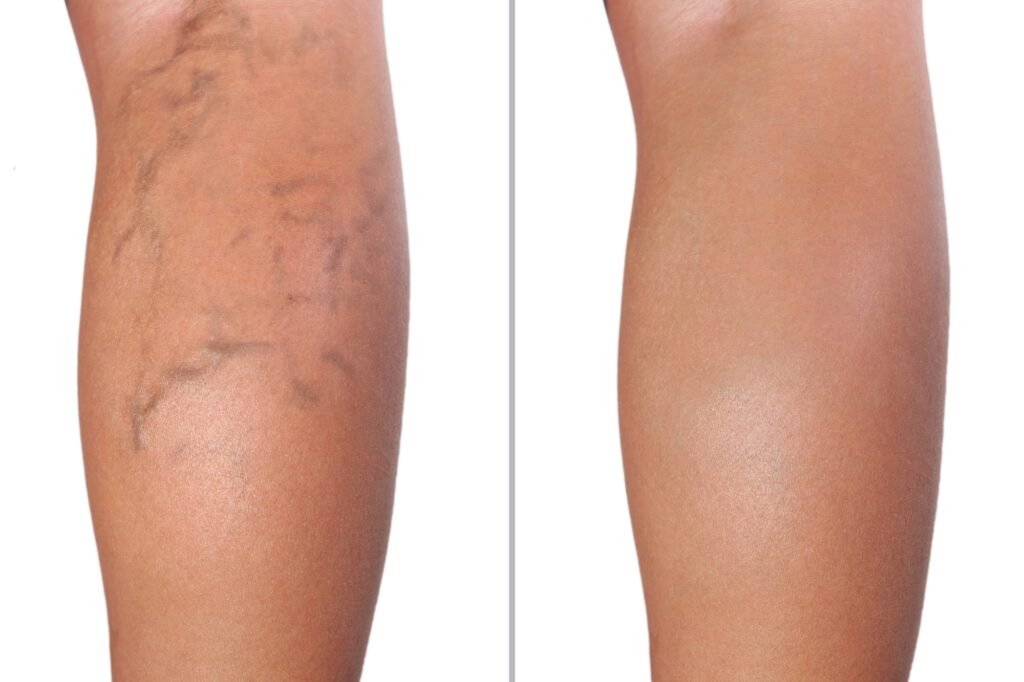Let’s remove those pesky spider veins.
Our expert medical team is dedicated to providing advanced and personalized spider vein treatments to help you feel more comfortable in your own skin.
Spider vein treatment refers to procedures aimed at reducing or eliminating the appearance of spider veins, which are small, dilated blood vessels that often appear close to the surface of the skin.
These veins can be red, blue, or purple and are commonly found on the legs and face.

Spider vein treatment
Spider vein treatment using a laser, known as laser therapy or laser vein removal, is a minimally invasive procedure designed to target and eliminate small, visible veins close to the surface of the skin. The process typically involves the following steps:
Consultation: Before the treatment, you will have a consultation with a healthcare professional. During this consultation, your medical history will be reviewed, and the practitioner will examine the spider veins to determine if laser therapy is a suitable option for you.
Preparing the Skin: On the day of the procedure, the treatment area will be cleansed, and a topical anesthetic may be applied to minimize discomfort during the treatment.
Laser Application: The practitioner will use a specialized laser device that emits a focused beam of light. The laser energy is absorbed by the hemoglobin in the blood, causing the blood vessel to coagulate and collapse.
Targeting Spider Veins: The laser is precisely directed at the spider veins. The energy from the laser selectively targets the pigments in the blood vessels while sparing the surrounding skin.
Cooling Mechanism: Many laser systems incorporate a cooling mechanism, such as a cooling spray or a chilled tip, to minimize any discomfort and protect the outer layers of the skin.
Formation of Scabs: After the laser treatment, small scabs may form on the treated veins. These scabs are a normal part of the healing process and will naturally slough off as the skin heals.
Post-Treatment Care: The healthcare provider will provide post-care instructions, which may include avoiding sun exposure, refraining from strenuous activities, and using prescribed or over-the-counter creams to promote healing.
Multiple Sessions: Depending on the extent of the spider veins and the desired results, multiple laser sessions may be recommended. These sessions are usually scheduled several weeks apart to allow for optimal healing.
Gradual Improvement: Over time, the treated spider veins fade as the body absorbs the coagulated blood and the surrounding tissues heal. Patients typically notice a gradual improvement in the appearance of their skin.
Follow-Up Consultations: Follow-up consultations with the healthcare provider allow them to assess the results, address any concerns, and determine if additional sessions are needed.
Spider Vein Treatment Areas
Spider Vein Pre-Care Instructions
Consultation: Schedule a thorough consultation with our experienced healthcare professional to discuss your medical history, any existing conditions, and expectations from the treatment. This information helps customize the procedure to your specific needs.
Avoid Sun Exposure: Minimize sun exposure to the treatment areas for at least two weeks before the procedure. Sunburned or tanned skin can be more sensitive, and avoiding sun exposure helps reduce the risk of complications.
Discontinue Blood-Thinning Medications: If approved by your healthcare provider, consider discontinuing blood-thinning medications or supplements (such as aspirin or fish oil) a few days before the procedure. This helps minimize the risk of bleeding during and after treatment.
Stay Hydrated: Maintain proper hydration by drinking an adequate amount of water in the days leading up to your treatment. Hydrated skin is more pliable and may contribute to a smoother procedure.
Gentle Skincare: Use gentle skincare products on the treatment areas. Avoid harsh exfoliants or retinoids in the days leading up to your appointment, as these products can increase skin sensitivity.
Inform Your Provider: Notify your healthcare provider of any changes in your health or medications since your initial consultation. This ensures that they have the most up-to-date information to tailor the treatment to your specific needs.
Comfortable Clothing: Wear loose, comfortable clothing on the day of the procedure, especially if the spider veins are located on the legs. This helps minimize friction and irritation post-treatment.
Clarify Any Concerns: If you have any questions or concerns about the procedure, downtime, or aftercare, do not hesitate to discuss them with your healthcare provider during your final pre-treatment consultation.
Spider Vein Post-Care Instructions
Gentle Care: Treat the treated areas with care. Avoid rubbing, scratching, or picking at the skin to minimize the risk of irritation, bruising, or infection.
Compression Garments: Your healthcare provider may recommend wearing compression stockings or garments to promote circulation and reduce swelling. Follow their instructions on when and how long to wear these garments.
Stay Hydrated: Maintain proper hydration by drinking plenty of water. Hydration supports overall skin health and may contribute to a smoother recovery.
Avoid Sun Exposure: Protect the treated areas from direct sunlight. If sun exposure is unavoidable, apply a broad-spectrum sunscreen with a high SPF to prevent sun damage.
Gentle Cleansing: Cleanse the treated areas gently with mild soap and water. Avoid using harsh cleansers or exfoliants on the treated skin for a specified period as recommended by your healthcare provider.
Avoid Hot Baths and Saunas: Refrain from hot baths, saunas, or activities that may cause excessive sweating for a few days post-treatment. These can potentially irritate the treated areas.
Follow-Up Appointments: Attend any follow-up appointments scheduled by your healthcare provider. These appointments allow them to assess the healing process and address any concerns.
Monitor for Complications: Keep an eye on the treated areas for any signs of infection, increased redness, swelling, or persistent pain. If you notice any unusual symptoms, contact your healthcare provider promptly.
Gradual Return to Activities: Resume normal activities gradually, as advised by your healthcare provider. Avoid strenuous exercise or heavy lifting for a specified period to minimize stress on the treated veins.
Patience with Results: Results may take time to fully manifest. Be patient and realistic about the timeline for optimal outcomes. If you have concerns or questions about the healing process, discuss them with your healthcare provider.
Maintain Healthy Lifestyle: Adopt a healthy lifestyle that includes regular exercise, a balanced diet, and proper hydration to support overall vascular health.
Frequently asked questions
Book Your Spider Vein Treatment Today
Book your spider vein appointment in Pensacola, FL, and speak to one of our trained providers to learn more.
